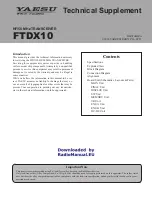
NV5/NV3.5 Troubleshooting Manual
Reading Electrical Schematics
Page 5-2
Issue 3.2 2014-12-10
Unique symbols
Nautel uses unique symbols on electrical schematics to describe logic (two-state) signals. These
signals differ from single-state signals or analog signals that may have multiple values.
Type of inputs and outputs
On electrical schematics, names used to describe logic (two-state) input and output signals are
prefixed with a
#
symbol.
Logic level convention
The
#
prefix identifies an input or output signal that has two distinct states:
high
and
low
.
The suffix on an input or output signal name identifies the
active
(true) state of the signal. The
high
suffix
(+) indicates the more positive of the two levels used to represent the logic states. The
low suffix
(-) indicates the less positive of the two levels.
Two types of logic, positive and negative, may be represented on a particular schematic. In positive
logic,
high
represents the
active
(true) state, and
low
represents the
inactive
(false) state. In negative
logic,
low
represents the
active
(true) state, and
high
represents the
inactive
(false) state.
Identifying schematic diagrams
Each electrical schematic in this section is identified by a number that is both the figure number and
the page number. The numbers are assigned sequentially are prefixed by the letters
SD
. The electrical
schematics and logic diagrams included in this section are listed in
Structure of schematics
The electrical schematics are structured in a hierarchical format that is based on function and signal
flow. Wherever practical, the signal flow is from left to right. Normally, inputs originate on the left-
hand side and outputs extend to the right-hand side. Exceptions are shown by an arrow indicating the
direction of signal flow.
Note: The physical location of a part or assembly was not necessarily a factor during creation of the
schematic. The full reference designation assigned to a part or assembly, in conjunction with the family
tree (see
Section 3, “Parts Lists” on page 3-1
) and the assembly detail drawings (see
6, “Mechanical Drawings” on page 6-1
), will identify its location.
Summary of Contents for NV3.5
Page 2: ......
Page 4: ......
Page 8: ...NV5 NV3 5 Troubleshooting Manual Page viii Issue 3 2 2014 12 10...
Page 168: ...NV5 NV3 5 Troubleshooting Manual Wiring connector lists Page 4 16 Issue 3 2 2014 12 10...
Page 174: ...NV5 NV3 5 Troubleshooting Manual Reading Electrical Schematics Page 5 6 Issue 3 2 2014 12 10...
Page 196: ...Issue 3 2 2014 12 10 SD 20 Figure SD 20 Power Amplifier Pallet CD2011B...
Page 212: ...Issue 3 2 2014 12 10 MD 6 Figure MD 6 NAI17 RF Drive Splitter Changeover Assembly A2 A1...
Page 213: ...Issue 3 2 2014 12 10 MD 7 Figure MD 7 Ac Distribution Assembly 206 5150 01...
Page 217: ...Issue 3 2 2014 12 10 MD 11 Figure MD 11 NAL09A 2 Input Reject Load Assembly A1...
Page 227: ......
















































